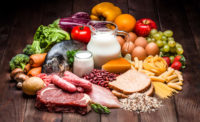All that sounds good, no? Unfortunately, no. The issue of food is politicized, with some wanting government to legislate nutrition, others wanting government to butt out entirely. Environmentalists, animal rights activists and food bloggers all press their points of view on dairy processors. It’s become a game of gotcha! What can be lost is the inherent quality of milk and other products made with milk.
Sad to say, but food is not getting into the homes and onto the plates of the nation’s citizenry. In 2010, almost 15% of households (17.2 million) were characterized as “food insecure.” That’s a federal government measurement defined as when all people at all times do not have access to sufficient, safe and nutritious food to maintain a healthy and active life. For households headed by unmarried women, the figure is 35.1%. These are our neighbors, co-workers and perhaps our relatives. Professor Phillip Tong touches on food insecurity in his column “Formulating the next generation of cultured dairy foods” (page 24).
It’s not that the poor are making poor food choices, either. A USDA study finds that those receiving food aid are no different than wealthier Americans when it comes to buying the major food categories. See “Dairy is in the diet of poor Americans,” page 12. And it turns out that “food deserts” (the scarcity of retail grocery options in poor neighborhoods) might be more anecdotal than factual.
It is a fact that children go to school hungry. Some can receive a free breakfast. They might eat it, too, unless they feel stigmatized by their peers who tease them about being poor. In New York City, some parents are pushing back on a free breakfast program that serves the meal in classrooms instead of the cafeteria. They worry that their children are eating breakfast at home then accepting another meal in the classroom. Double dipping, if you will.
Reports the New York Times: “The city’s health department hit the pause button after a study found that the Breakfast in the Classroom program, now used in 381 of the city’s 1,750 schools, was problematic because some children might be ‘inadvertently taking in excess calories by eating in multiple locations’ — in other words, having a meal at home, or snacking on the way to school, then eating again in school.”
Chicago schools also have breakfast in the classroom. But the pushback isn’t from parents. It’s from teachers who resent having to serve breakfast and clean up afterwards because it takes away from instructional time. They have a point, but they also miss the point: hungry children don’t learn.
A nanny or a guide?
Meanwhile, the federal government is derided as a nanny that nags us to cut back on salt and fat. City governments want to tax soft drinks and other high-calorie beverages. Government has a legitimate role in promoting healthy eating and being active. First Lady Michelle Obama’s Let’s Move! campaign encourages 60 minutes of activity daily for children. (If only we joined them; we’d be too out of breath to complain about anything.)
Despite the grumbling, by and large, the dairy industry applauds the federal government’s most recent Dietary Guidelines for Americans which favor low-fat dairy products. The new guidelines even encourage more dairy consumption for children. That is not a bad change.
I won’t argue that the Food Network, glorifier of fatty foods and drinks (see “Diners, Drive-ins and Dives” and anything starring Paula Deen) caused the country’s obesity problem. We eat those foods because they taste good and we like them. I will suggest that the media’s interest in cooking at home has raised awareness of food production, for the good. We want to know where food comes from and how it is made. The food media is emphasizing quality ingredients.
Talk ‘good’ not ‘cheap’
Dairy processors benefit when the conversation changes from cheap food to good food. A glass of whole milk is a good source of Vitamin D, riboflavin, vitamin B12, calcium and phosphorus. And there is no sugar added, mind you. A 6-ounce serving of Greek yogurt can deliver 15 to 20 grams of protein (about that in 2 to 3 ounces of lean meat). Fill in the blanks yourself to tell the nutrition story of cheese. Dairy processors also add functional ingredients to their foods and beverages to supplement milk’s natural nutrition. Probiotics, omega-3s, fiber and CLAs, to name a few, impart benefits to our health and well being.
It is disgraceful that more than 15% of our neighbors do not have adequate nutrition at some point in a year. Government assistance programs can deal with that, and they do. It is also disgraceful that nearly 36% of adults are obese. Personal responsibility can deal with that. Educational programs by the dairy industry about foods and beverages help everyone understand the consequences of the food choices we make. You can work to make dairy the first choice.
Eat well and be active. It’s a game anyone can win.


